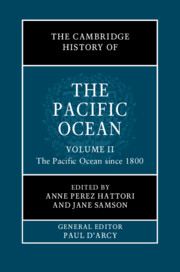Book contents
- The Cambridge History of the Pacific Ocean
- The Cambridge History of the Pacific Ocean
- The Cambridge History of the Pacific Ocean
- Copyright page
- Contents
- Figures
- Tables
- Contributors to Volume II
- Frontispiece
- General Editor’s Introduction
- Preface to Volume II
- Part VII Rethinking the Pacific
- Part VIII Approaches, Sources, and Subaltern Histories of the Modern Pacific
- Part IX Culture Contact and the Impact of Pre-colonial European Influences
- Part X The Colonial Era in the Pacific
- Part XI The Pacific Century?
- 54 The USA and the Pacific since 1800
- 55 World War II and the Pacific
- 56 The Nuclear Pacific
- 57 Shrinking the Pacific since 1945
- 58 China and the Pacific since 1949
- 59 Pacific Island Nations since Independence
- Part XII Pacific Futures
- References to Volume II
- Index
54 - The USA and the Pacific since 1800
Manifestly Facing West
from Part XI - The Pacific Century?
Published online by Cambridge University Press: 11 November 2022
- The Cambridge History of the Pacific Ocean
- The Cambridge History of the Pacific Ocean
- The Cambridge History of the Pacific Ocean
- Copyright page
- Contents
- Figures
- Tables
- Contributors to Volume II
- Frontispiece
- General Editor’s Introduction
- Preface to Volume II
- Part VII Rethinking the Pacific
- Part VIII Approaches, Sources, and Subaltern Histories of the Modern Pacific
- Part IX Culture Contact and the Impact of Pre-colonial European Influences
- Part X The Colonial Era in the Pacific
- Part XI The Pacific Century?
- 54 The USA and the Pacific since 1800
- 55 World War II and the Pacific
- 56 The Nuclear Pacific
- 57 Shrinking the Pacific since 1945
- 58 China and the Pacific since 1949
- 59 Pacific Island Nations since Independence
- Part XII Pacific Futures
- References to Volume II
- Index
Summary
On 11 October 2011, then Secretary of State Hillary Clinton announced a major shift in United States foreign policy.1 Anticipating a reduction in American forces in Iraq and Afghanistan, major battlegrounds of the war on terror, Clinton pointed to the Asia-Pacific region as the ‘driver of global politics’. Defining the region broadly as spanning both the Indian and the Pacific oceans and including such rising powers as China, India, and Indonesia, Clinton noted that the region held half the world’s population, figured prominently in the global economy, and was the source of major environmental problems confronting the globe. Given these facts, the United States now needed to make substantial diplomatic, strategic, and economic investments in the region. Coming to be called the ‘Pacific pivot’, Clinton’s pronouncement was only the most recent reiteration of a long standing history of American interest and activity in the larger region. While there are those who argue that American interests have often been both subservient to and informed by priorities elsewhere in the world, most notably Europe, the region has been a consistent theatre of American desire, ambition, profit, and power. This chapter offers an overview of the United States’ historical presence on the ocean, islands, and bordering lands of the region conventionally labelled the ‘Pacific’, a term that, as Clinton’s policy pronouncement indicates, is fluid, amorphous, and subject to the changing times and contexts in which it is deployed.2
- Type
- Chapter
- Information
- The Cambridge History of the Pacific Ocean , pp. 563 - 587Publisher: Cambridge University PressPrint publication year: 2023



